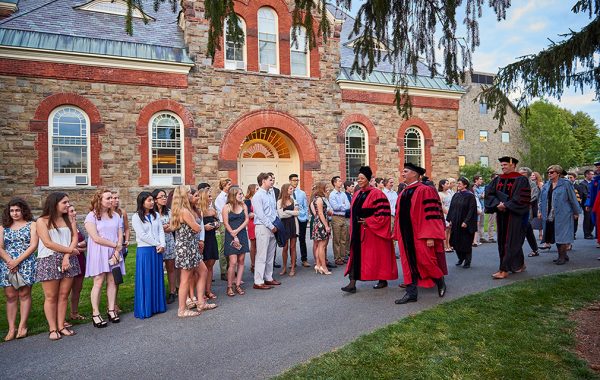
President Brian Casey and Provost and Dean of the Faculty Tracey Hucks lead the procession at the convocation ceremony. Photo by Andrew Daddio
Last summer, my evening walks with my dog, Emrys, around the Academic Quad were as scenic as ever. But we agreed that there was something missing. Rather, there were more than 2,900 someones missing. While reunion, admission tours, and countless camps ensure a steady flow of visitors to Colgate between May and September, we miss the undergraduates when they are away.
Thankfully, Colgate students began to return on August 25, and campus has resumed its autumn patterns of activity. Among those climbing the hill are the 773 members of the Class of 2021. They come from 41 states — half are from states other than New York, Pennsylvania, Massachusetts, New Jersey, and Connecticut. Domestic students of color account for 21 percent of the class, while 30 percent identify as multicultural. Eleven of every 100 are first-generation college students; 31 of every 100 receive need-based financial aid. Academically, these are some of the world’s brightest undergraduates, selected from 8,542 applicants. They have a composite average of 31.6 on the ACT and an average SAT score of 1394 on the new scale.
Members of the Colgate community learn of these sorts of statistics every year, long before cars start rolling onto Whitnall Field, packed with pillows, electronics, books, and posters. But we have our first chance to meet the personalities behind the statistics on move-in day. Greeting a new class in person — interacting one-on-one — reminds me of the pleasure behind the work that my colleagues and I have been called to do. Addressing the Class of 2021 at convocation, Professor Robert Garland rightly said, “We are the privileged ones, all of us here in this chapel tonight. You, because you are about to go on a roller coaster ride through human learning lasting four years — and will meet us. We, because we have the best job in the world — and will meet you.”
There was a time (many alumni reading this magazine will remember it) when meeting the entire student body was half as difficult, because it was roughly half its current size. It operated in fewer square feet, located on fewer acres. It spawned the “hello” tradition.
Roughly a half century later, the university now houses a population of nearly 3,000 coming to Hamilton from around the nation and around the world. Colgate is larger, more complex, engaged in the world in ways that would have seemed impossible just a few decades ago. Our faculty is larger, the size of the staff is also bigger.
But Emrys and I have discovered an important fact: the hello tradition works as well with 3,000 students as it does with 1,300. It works with faculty and staff as well. One person at a time, we greet our way from Raab House to the Coop; from Andrews to the chapel; from Lawrence to Olin. Up and down the hill. Through tailgates on weekends and in classes on weekdays. I have encouraged faculty and staff to continue and to extend the hello tradition, because this one word can transform statistics into individuals. As our classes grow evermore diverse in a variety of ways, the hello tradition becomes an imperative. By greeting each other and striking up relationships with those who look, think, and act in ways that are different from ourselves, we make the Colgate experience more than academic. We learn the value of collegiality and understanding that are rare in today’s world, yet so important to its survival.
I am proud of the numbers that show our classes continuing to improve, continuing to set the pace for other universities, continuing to ensure that Colgate is the envy of its peers. I offer my thanks to the alumni and parents who serve as our ambassadors in states across America.
It is the people who have made Colgate what it is today and what it will be in the future. That is why, when the summer comes and many of those people scatter to all points of the compass, Emrys and I look at the campus in the sunset and count the days between commencement and convocation.






